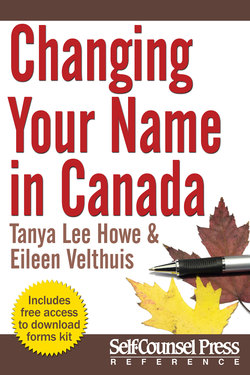Читать книгу Changing Your Name in Canada - Eileen Velthuis - Страница 3
На сайте Литреса книга снята с продажи.
Chapter 1 An Introduction to Changing Your Name in Canada
ОглавлениеIn the past, changing a surname is something most Canadian men never did, and most Canadian women would only do once or twice in their lives when they got married or divorced. Nowadays more men are opting to share their spouse’s last name by combining the two names or even switching to a spouse’s last name, many women still change their names upon marriage or divorce, and some people change their names for reasons that have nothing to do with marriage or divorce.
Although changing a name is a task infrequently done by any one individual, it can be quite involved. There are so many places, people, and organizations you need to contact when you want your name changed, and each one has its own ways to do it, and its own red tape and bureaucracy. At the end of the book, in Appendix II, you’ll find an Identification Update List to help you contact everyone who needs to be alerted to your name change.
To complicate matters more, each province and territory has its own vital statistics agency rules and legal acts when it comes to formally or informally changing a name. A formal name change means a legal change to the first name, surname, or both in which the person’s birth records are updated with the new name and a new birth certificate is issued. An informal name change usually means opting to use your spouse’s surname when you get married, or switching back to a previous surname or birth name if you’ve recently divorced. An informal change does not affect your birth certificate.
People change their names for a variety of reasons, which may include the following:
• Marriage.
• Divorce.
• Correction of a typo or changing an odd spelling of a name.
• Dislike of the name that was given at birth.
• To remove problems with confusion or mispronunciations.
• To use a name the person is known for such as a nickname (e.g., the name is Robert but the person is only known as Bob).
• Protection from others, perhaps to prevent harassment by an individual.
Names are inherently personal, and as such, your reason for changing your name is your choice. Whatever your reason, this book will help you know what to do and in what order, depending on where you reside in the country, to change your name legally and across all of your identification and documentation.
Depending on where you currently reside, and where you were born, you may need to contact your former jurisdiction as well as your current one. This book discusses the procedures for every province and territory in Canada. The Resources section in Appendix I lists Vital Statistics contact information in other parts of the world.
This book discusses name changes for marriage, divorce, amendments to names, and how to change a child’s name. It also includes the costs, which were current at the time of publication but are subject to change. Turn to the chapter for your province of residence for specific instructions.
